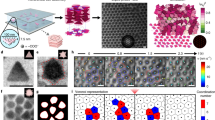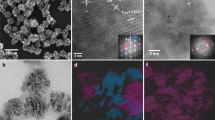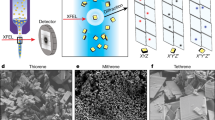Abstract
On solvent evaporation, non-interacting monodisperse colloidal particles self-assemble into a close-packed superlattice. Although the initial and final states can be readily characterized, little is known about the dynamic transformation from colloid to superlattice. Here, by using in situ grazing-incidence X-ray scattering, we tracked the self-assembly of lead sulfide nanocrystals in real time. Following the first appearance of an ordered arrangement, the superlattice underwent uniaxial contraction and collective rotation as it approached its final body-centred cubic structure. The nanocrystals became crystallographically aligned early in the overall self-assembly process, showing that nanocrystal ordering occurs on a faster timescale than superlattice densification. Our findings demonstrate that synchrotron X-ray scattering is a viable method for studying self-assembly in its native environment, with ample time resolution to extract kinetic rates and observe intermediate configurations. The method could be used for real-time direction of self-assembly processes and to better understand the forces governing self-organization of soft materials.
This is a preview of subscription content, access via your institution
Access options
Subscribe to this journal
Receive 12 print issues and online access
$259.00 per year
only $21.58 per issue
Buy this article
- Purchase on Springer Link
- Instant access to full article PDF
Prices may be subject to local taxes which are calculated during checkout





Similar content being viewed by others
References
Williams, R. C. & Smith, K. M. Crystallizable insect virus. Nature 179, 119–120 (1957).
Jones, J. B., Segnit, E. R. & Sanders, J. V. Structure of opal. Nature 204, 990–991 (1964).
Alivisatos, A. P. Semiconductor clusters, nanocrystals, and quantum dots. Science 271, 933–937 (1996).
Kovalenko, M. V. et al. Prospects of nanoscience with nanocrystals. ACS Nano 9, 1012–1057 (2015).
Murray, C. B., Kagan, C. R. & Bawendi, M. G. Self-organization of CdSe nanocrystallites into three-dimensional quantum dot superlattices. Science 270, 1335–1338 (1995).
Shevchenko, E. V., Talapin, D. V., Kotov, N. A., O’Brien, S. & Murray, C. B. Structural diversity in binary nanoparticle superlattices. Nature 439, 55–59 (2006).
Smith, D. K., Goodfellow, B., Smilgies, D.-M. & Korgel, B. A. Self-assembled simple hexagonal AB2 binary nanocrystal superlattices: SEM, GISAXS, and defects. J. Am. Chem. Soc. 131, 3281–3290 (2009).
Bodnarchuk, M. I., Kovalenko, M. V., Heiss, W. & Talapin, D. V. Energetic and entropic contributions to self-assembly of binary nanocrystal superlattices: temperature as the structure-directing factor. J. Am. Chem. Soc. 132, 11967–11977 (2010).
Korgel, B. A. & Fitzmaurice, D. Small-angle X-ray-scattering study of silver-nanocrystal disorder-order phase transitions. Phys. Rev. B 59, 14191–14201 (1999).
Robinson, R. D. et al. Spontaneous superlattice formation in nanorods through partial cation exchange. Science 317, 355–358 (2007).
Dong, A., Chen, J., Vora, P. M., Kikkawa, J. M. & Murray, C. B. Binary nanocrystal superlattice membranes self-assembled at the liquid-air interface. Nature 466, 474–477 (2010).
Talapin, D. V., Lee, J.-S., Kovalenko, M. V. & Shevchenko, E. V. Prospects of colloidal nanocrystals for electronic and optoelectronic applications. Chem. Rev. 110, 389–458 (2010).
Hanrath, T. Colloidal nanocrystal quantum dot assemblies as artificial solids. J. Vac. Sci. Technol. A 30, 030802 (2012).
Park, J. et al. Direct observation of nanoparticle superlattice formation by using liquid cell transmission electron microscopy. ACS Nano 6, 2078–2085 (2012).
Quan, Z. et al. Tilted face-centered-cubic supercrystals of PbS nanocubes. Nano Lett. 12, 4409–4413 (2012).
Quan, Z. et al. Solvent-mediated self-assembly of nanocube superlattices. J. Am. Chem. Soc. 136, 1352–1359 (2014).
Lu, F., Yager, K. G., Zhang, Y., Xin, H. & Gang, O. Superlattices assembled through shape-induced directional binding. Nature Commun. 6, 6912 (2015).
Ip, A. H. et al. Hybrid passivated colloidal quantum dot solids. Nature Nanotech. 7, 577–582 (2012).
Chuang, C. M., Brown, P. R., Bulović, V. & Bawendi, M. G. Improved performance and stability in quantum dot solar cells through band alignment engineering. Nature Mater. 13, 796–801 (2014).
Sun, L. et al. Bright infrared quantum-dot light-emitting diodes through inter-dot spacing control. Nature Nanotech. 7, 369–373 (2012).
Supran, G. J. et al. High-performance shortwave-infrared light-emitting devices using core-shell (PbS-CdS) colloidal quantum dots. Adv. Mater. 27, 1437–1442 (2015).
Weidman, M. C., Beck, M. E., Hoffman, R. S., Prins, F. & Tisdale, W. A. Monodisperse, air-stable PbS nanocrystals via precursor stoichiometry control. ACS Nano 8, 6363–6371 (2014).
Choi, H., Ko, J.-H., Kim, Y.-H. & Jeong, S. Steric-hindrance-driven shape transition in PbS quantum dots: understanding size-dependent stability. J. Am. Chem. Soc. 135, 5278–5281 (2013).
Choi, J. J. et al. Controlling nanocrystal superlattice symmetry and shape-anisotropic interactions through variable ligand surface coverage. J. Am. Chem. Soc. 133, 3131–3138 (2011).
Zherebetskyy, D. et al. Hydroxylation of the surface of PbS nanocrystals passivated with oleic acid. Science 344, 1380–1384 (2014).
Weidman, M. C., Yager, K. G. & Tisdale, W. A. Interparticle spacing and structural ordering in superlattice PbS nanocrystal solids undergoing ligand exchange. Chem. Mater. 27, 474–482 (2015).
Bian, K. et al. Shape-anisotropy driven symmetry transformations in nanocrystal superlattice polymorphs. ACS Nano 5, 2815–2823 (2011).
Goodfellow, B. W., Yu, Y., Bosoy, C. A., Smilgies, D.-M. & Korgel, B. A. The role of ligand packing frustration in body-centered cubic (bcc) superlattices of colloidal nanocrystals. J. Phys. Chem. Lett. 6, 2406–2412 (2015).
Bain, E. C. The nature of martensite. Trans. Am. Inst. Min. Metall. Eng. 70, 25–46 (1924).
Crossland, E. J. W. et al. A bicontinuous double gyroid hybrid solar cell. Nano Lett. 9, 2807–2812 (2009).
Kaushik, A. P. & Clancy, P. Explicit all-atom modeling of realistically sized ligand-capped nanocrystals. J. Chem. Phys. 136, 114702 (2012).
Kaushik, A. P. & Clancy, P. Solvent-driven symmetry of self-assembled nanocrystal superlattices—a computational study. J. Comput. Chem. 34, 523–532 (2013).
Gast, A. P. & Russel, W. B. Simple ordering in complex fluids. Phys. Today 51, 24–30 (December, 1998).
Smilgies, D.-M. & Blasini, D. R. Indexation scheme for oriented molecular thin films studied with grazing-incidence reciprocal-space mapping. J. Appl. Crystallogr. 40, 716–718 (2007).
Busch, P., Rauscher, M., Smilgies, D.-M., Posselt, D. & Papadakis, C. M. Grazing-incidence small-angle X-ray scattering from thin polymer films with lamellar structures - the scattering cross section in the distorted-wave Born approximation. J. Appl. Crystallogr. 39, 433–442 (2006).
Acknowledgements
We thank R. Li for assistance with the experimental set-up and measurements. This work was supported as part of the Center for Excitonics, an Energy Frontier Research Center funded by the US Department of Energy, Office of Science, Office of Basic Energy Sciences under award DE-SC0001088 (MIT). This work is based on research conducted at the Cornell High Energy Synchrotron Source (CHESS), which is supported by the National Science Foundation and the National Institutes of Health/National Institute of General Medical Sciences under NSF award DMR-1332208. This work made use of the MRSEC Shared Experimental Facilities at MIT, supported by the National Science Foundation under award number DMR-08-19762. M.C.W. was supported by the National Science Foundation Graduate Research Fellowship under grant number 1122374.
Author information
Authors and Affiliations
Contributions
M.C.W. and W.A.T. conceived and designed the project. D.-M.S. conceived and designed the in situ X-ray scattering system. M.C.W. synthesized materials and performed all experiments. M.C.W. and D.-M.S. indexed and analysed the X-ray scattering patterns. All authors discussed the results and interpretation. M.C.W. wrote the manuscript with contributions from the other authors.
Corresponding author
Ethics declarations
Competing interests
The authors declare no competing financial interests.
Supplementary information
Supplementary Information
Supplementary Information (PDF 3049 kb)
Supplementary Movie 1
Supplementary Movie 1 (MOV 4325 kb)
Supplementary Movie 2
Supplementary Movie 2 (MOV 4106 kb)
Supplementary Movie 3
Supplementary Movie 3 (MOV 4652 kb)
Rights and permissions
About this article
Cite this article
Weidman, M., Smilgies, DM. & Tisdale, W. Kinetics of the self-assembly of nanocrystal superlattices measured by real-time in situ X-ray scattering. Nature Mater 15, 775–781 (2016). https://doi.org/10.1038/nmat4600
Received:
Accepted:
Published:
Issue Date:
DOI: https://doi.org/10.1038/nmat4600
This article is cited by
-
Nanocrystal phononics
Nature Materials (2023)
-
Crystallization of binary nanocrystal superlattices and the relevance of short-range attraction
Nature Synthesis (2023)
-
Enabling metallic behaviour in two-dimensional superlattice of semiconductor colloidal quantum dots
Nature Communications (2023)
-
Fast calculation of scattering patterns using hypergeometric function algorithms
Scientific Reports (2023)
-
Inkjet printing of epitaxially connected nanocrystal superlattices
Nano Research (2022)



